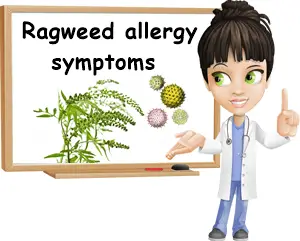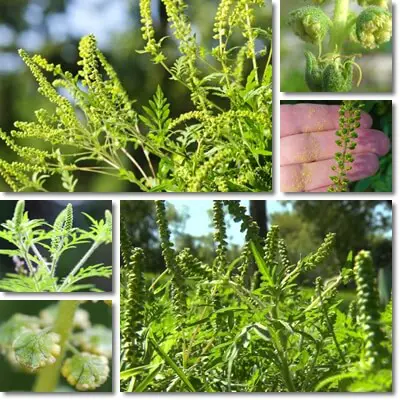If you find yourself sneezing a lot in September or experience watery eyes, runny nose and serious postnasal drip, than you might just be allergic to ragweed pollen.
Ragweed (Ambrosia) is a weed in the daisy family that produces a highly allergenic pollen which is a cause for allergic reactions.
Ragweed is one of the most common fall allergies throughout North America and Europe and one of the lengthiest, as ragweed pollen season can extend from late August to late October, or until the first frost occurs.
What is ragweed (ambrosia)?
Ragweed is a weed found throughout North America, Europe, Asia, Africa, Australia, New Zealand and essentially any temperate area in the world. It is a member of the daisy family which includes others common species such as dandelion, daisy, Echinacea, calendula (marigolds) and yarrow. Ragweed is an invasive species and, similar to many daisy species, a highly allergenic plant. It alone is responsible for almost half of the late summer-fall allergies. The common ragweed (Ambrosia artemisiifolia) and the great ragweed (Ambrosia trifida) are two highly widespread ragweed species.

When is ragweed allergy season?
Ragweed allergy season is roughly late summer to mid to late fall, depending on the region and yearly weather variations. However, ongoing climate changes have produced measurable changes in original ragweed season with shifts in the beginning and end of the seasons, increasingly warmer temperatures, dry weather and other factors all affecting ragweed plants distribution and life cycle.
For example, as a result of higher temperatures and desertification advancing, ragweed species have not only spread outside their current areas, but also lengthened their life cycle and pollen production period which is causing ragweed pollen season to extend till late fall in most regions where the plant is present. Less rainfall also favors the spread of pollen particles, resulting in more severe allergies.
How long does ragweed allergy season last?
Ragweed allergy season in 2015, 2016, 2017, 2018, 2019 and 2020 lasted roughly from late August till November, peaking in September. Ragweed season in 2021 began early September in most regions, with peak season starting mid-September; the season is expected to last until late October or early November at the latest.
What does ragweed look like?
Ragweed is, as its name suggests, a weed. It can be as short as a few centimeters or as tall as four meters. It has composite green leaves with three to five leaflets, smooth in some species, toothed in others.
The leaves look similar in appearance to fern leaves, but less divided. Personally, they remind me of tomato leaves, just pointier. However, there are quite a few different species and appearance differs between plants of different species.
Ragweed flowering season peaks in September and most plants of the species produce tiny yellow-green, cup-like flowers arranged in long, upright spikes, filled with a highly prolific yellow pollen.
The pollen is carried by the wind over long distances which is how both ragweed plants and ragweed allergy spread.

What causes ragweed allergy?
What causes ragweed allergy is the very pollen of the plant species. Ragweed plants are highly prolific pollen producers. The spike-shaped plants are made up of numerous tiny, yellow-green flowers which release impressive amounts of yellow pollen particles. Because they are light, these pollen particles travel easily in the air over extremely long distances, hence the reason why ragweed allergy is so widespread. In addition to this, ragweed pollen is measurably more allergenic than other types of pollen, adding to the severity of the allergy symptoms.
What are the symptoms of ragweed allergy?
Ragweed allergy causes primarily allergic rhinitis, also known as hay fever, which is characterized by the following signs and symptoms:
- Sneezing and a runny nose with clear or white mucus (the mucus is a result of inflammatory response triggered by the immune system activating against the ragweed pollen). Also see what are other nose mucus colors and what they mean.
- Nasal congestion, especially after sneezing several times.
- Postnasal drip which often causes irritation of the airways and even light coughing to displace mucus sticking to the back of the throat.
- Sore throat and hoarseness – light, do not progress in severity.
- Itchy mouth, itchy throat, a tingling sensation in the back of the throat, sometimes also itchy gums.
- Itchy ears (caused by the pollen entering the ears), sometimes also redness and a burning sensation (‘burning ears’).
- Itchy skin from direct contact with the pollen.
- Itchy, watery eyes, redness and swelling of the eyelids and undereye area (puffiness).
- Insomnia or, on the contrary, drowsiness or sleepiness, and tiredness and fatigue.
- Laryngospasms and asthma attacks.
How does ragweed allergy affect you?
Pollen activates the immune system because it is a foreign particle. Some immune systems being oversensitive or heightened, they react more aggressively to all foreign particles.
So when ragweed pollen comes into contact with the skin or is breathed in, the immune system activates and releases antibodies to capture it and eliminate it from the body.
This otherwise normal response causes inflammation in the body through the release of histamine from various white blood cells and can lead to airways becoming so inflamed their obstruct breathing.
If ragweed allergy is severe, contact with the pollen through skin and breathing can potentially escalate to anaphylactic shock. This is why it is vital to avoid allergy triggers at all costs, carry your essential medication with you at all times and seek medical help immediately if your condition deteriorates in the slightest.
Tips and solutions to manage ragweed allergy
There are two types of treatment for ragweed pollen allergy: medication and natural solutions. Depending on how severe your ragweed allergy is, you may find relief in either of the two treatment options or both. Bellow are the traditional ways to manage ragweed allergy and its symptoms and my personal four tips on how to deal with it:
1) Essential medication (e.g. asthma inhaler)
It is prescribed by a doctor following confirmation of ragweed pollen allergy. Skin prick tests, blood tests, antibody tests are commonly employed to diagnose allergies.
2) Antihistamines for symptoms management
Although not necessarily essential medication, antihistamines block histamine production reducing inflammation which improves symptoms.
However, antihistamines work best when taken prophylactically and do not constitute treatment.
3) Limit contact with ragweed pollen
This can be done as follows:
- Remove ragweed plants from your home garden, front and back yard to minimize exposure. Best to pull them from the ground.
- Avoid going out on hot, dry, windy days when pollen counts are usually very high.
- Change clothes after being outside.
- Do not sit on your bed with outside clothes so as to not contaminate the bedding with ragweed pollen.
- Do not bring shoes inside or leave them at the door.
- Shower every day before bed to remove pollen from hair, ears, face.
- Always wash your face after being outside and, if possible, also your hair to help clear pollen.
- Keep windows closed during the day to prevent pollen from getting in the house.
Ragweed pollen count is minimal on rainy days, early in the morning and at night, although weather conditions can easily impact pollen count.
4) Carry water with you at all times and stay hydrated
What I’ve learnt from my experience with pollen allergies is that it is extremely important to stay hydrated and always have water with you. If you breathe in pollen, you can avoid laryngospasms or even an asthma attack by taking small sips of water to wash down pollen that may get stuck to the throat and trigger an allergic reaction. If this doesn’t work, use your medication and seek medical help.
Sparkling water is better than still water, but any kind of water helps. You can also stay hydrated with the help of herbal teas, flavored water such as cucumber water and also sports drinks full of minerals.
5) Ragweed allergy foods to avoid
What you eat affects the severity of your allergies. During ragweed season it is important to avoid foods that create inflammation and make allergy symptoms worse. These include:
- Fizzy drinks: rich in sugar, they make pollen stick to the throat lining easier, creating the perfect environment for an allergy to ensure, and thicken mucus.
- Coffee, caffeinated beverages, alcohol, all cause a dry mouth and throat and favor pollen allergy symptoms.
- Milk and dairy: too much dairy thickens mucus which makes pollen allergies worse.
- Foods that cause acid reflux: foods that cause acid reflux increase the chances for laryngospasms and even asthma attacks during allergy season.
Other foods may also make allergies worse so consider individual triggers as well.
6) Vitamin C for a natural antihistamine
I take one gram of effervescent vitamin C daily starting several weeks before ragweed allergy season till after it ends. Vitamin C is a strong antioxidant and natural anti-inflammatory, reducing histamine production and improving symptoms of allergic rhinitis. It also helps me eliminate phlegm and sleep better. Talk to your doctor about the benefits of taking vitamin C for ragweed allergy.
